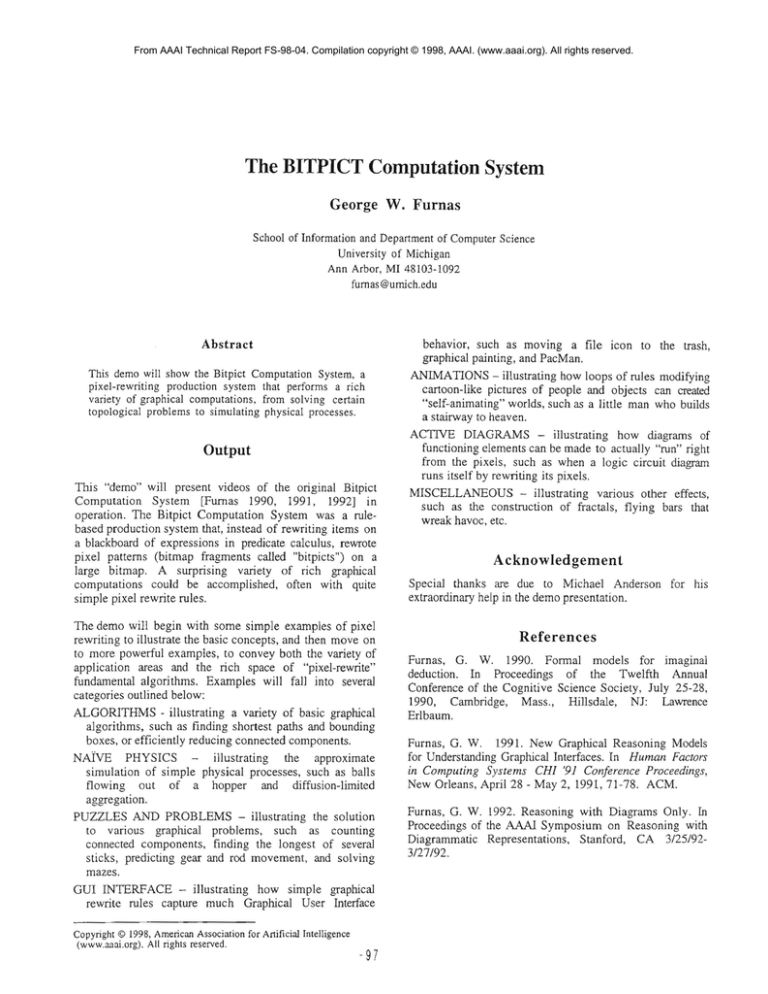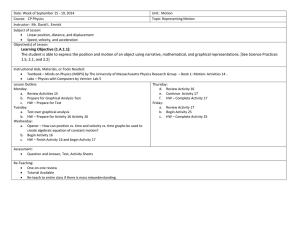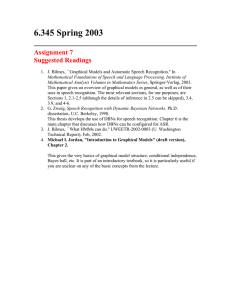
From AAAI Technical Report FS-98-04. Compilation copyright © 1998, AAAI. (www.aaai.org). All rights reserved.
The BITPICT Computation Systenl
George W. Furnas
School of Information and Department of Computer Science
University of Michigan
Ann Arbor, MI 48103-1092
fumas @umich.edu
Abstract
behavior, such as moving a file icon to the trash,
graphical painting, and PacMan.
This demo will show the Bitpict Computation System, a
pixel-rewriting production system that performs a rich
variety of graphical computations, from solving certain
topological problems to simulating physical processes.
ANllvlA TIONS - illustrating how loops of rules modifying
cartoon-like pictures of people and objects can created
"self-animating" worlds , such as a little man who builds
a stairway to heaven.
Output
ACTIVE DIAGRAMS - illustrating how diagrams of
functioning elements can be made to actually "run" right
from the pixels, such as when a logic circuit diagram
runs itself by rewriting its pixels.
This "demo" will present videos of the original Bitpict
Computation System [Furnas 1990, 1991 , 1992] in
operation. The Bitpict Computation System was a rulebased production system that, instead of rewriting items on
a blackboard of expressions in predicate calculus, rewrote
pixel patterns (bitmap fragments called "bitpicts ") on a
large bitmap. A surpri sing variety of rich graphical
computations could be accomplished, often with quite
simple pixel rewrite rules.
The demo will begin with some simple examples of pixel
rewriting to illustrate the basic concepts, and then move on
to more powerful examples, to convey both the variety of
application areas and the rich space of "pixel-rewrite"
fundamental algorithms. Examples will fall into several
categories outlined below:
ALGORITHMS - illustrating a variety of basic graphical
algorithms , such as find ing shortest paths and bounding
boxes, or efficiently reducing connected components.
NAIVE PHYSICS
illustrating the approximate
simulation of simple physical processes, such as balls
flowing out of a hopper and diffusion-limited
aggregation.
PUZZLES Al."l'D PROBLEMS - illustrating the solution
to various graphical problems, such as counting
connected components, finding the longest of several
sticks , predicting gear and rod movement, and solving
mazes.
GUr INTERFACE - illustrating how simple graphical
rewrite rules capture much Graphical User Interface
Copyri ght © 1998, American Association
(www.aaai .org). All rights reserved.
for Artificial Intelligence
- 97
MISCELLANEOUS - illustrating various other effects,
such as the construction of fractals , flying bars that
wreak havoc, etc.
Acknowledgement
Special thanks are due to Michael Anderson for his
extraordinary help in the demo presentation.
References
Furnas, G . W. 1990. Formal models for imaginal
deduction. In Proceedings of the Twelfth Annual
Conference of the Cognitive Science Society, July 25-28,
1990, Cambridge, Mass ., Hillsdale, NJ: Lawrence
Erlbaum.
Furnas, G. W. 1991. New Graphical Reasoning Models
for Understanding Graphical Interfaces. In Human Factors
in Computing Systems CHI '91 Conference Proceedings ,
New Orleans , April 28 - May 2, 1991,71-78. ACM.
Furnas, G. W . 1992. Reasoning with Diagrams Only . In
Proceedings of the AAAI Symposium on Reasoning with
Diagrammatic Representations, Stanford, CA 3/25/92-
3/27/92.
- 98-





